

Reusable Bags. Untitled. BIOPLANET CORP : Connectodex. Raw for Thirty Days - Part 2. Clearcote Eco. Plant and Grow Your Vegetable Packaging. UK-based design student Ben Huttly came up with an ingenious idea for vegetable labels that is both eco-friendly and beautifully designed: these biodegradable tags are embedded with plant seeds and then laser-cut to create a plantable packaging system.

From his website: Through experimentation and innovation I have developed a form of packaging that is 100 percent biodegradable and recyclable.If the packaging is discarded it will have a positive effect on the environment due to the seed embedded biodegradable paper. The twine used to secure the product and label is natural cotton and 100 percent biodegradable.The labels themselves have been produced using a laser cutting machine. This eliminates the use of harmful printing ink, as well as giving the packaging an esthetically pleasing organic look and feel.
Compostable & Biodegradable Foodservice Solutions. Changing The World Without Changing The Earth BioBag® is the world’s best selling brand of 100%certified compostable bags and films made from the bioplastic material, Mater-Bi.
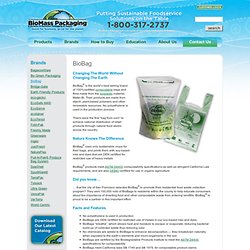
Their products are made from starch, plant-based polymers and other renewable resources. No polyethylene is used in the production process. Theirs were the first “bag from corn” to achieve national distribution of retail products through natural food stores across the country. Nature Knows The Difference. Compostable & Biodegradable Food Bags. Flat Bottom Gussets - Eco Clear Bags - More Bags. Sustainability Marketing, The New Rules of Green Marketing Book. Introducing WeHateToWaste.com Posted on January 07, 2013 by Jacquelyn Ottman I am excited to announce our new consumer-focused blog and website.
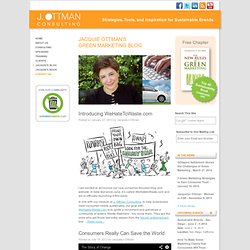
Check Out. Welcome! As per this blog post from July, we have officially closed the advanced suite of Flash tools (previously located at advanced.aviary.com) in order to focus on our new company direction powering the photo experience in 3rd party apps.

While we hoped that everyone would have taken the time to retrieve their files since our notice, we recognize that the message may not have been seen by everyone. Therefore, if you were not able to retrieve all of your files to date, please contact us at support@aviary.com from the email address associated with your account to help retrieve your files.
Do this quickly. Please note that after September 30th, 2012, we cannot guarantee that your files will still be available for us to retrieve. While the tools will remain offline, we may continue to explore new homes in whole or in part, for specific elements of the suite. Food - Free Resource for Graphic & Web Designers - Part 1. Swallowtail Garden Seeds Shopping Cart. Vegetables clip art. Los seis primeros pasos para abrir su negocio - Actualícese con La Prensa Web. PANAMÁ.Guía práctica para emprendedores.

Los trámites básicos tienen bajos costos y pueden concluirse en periodos de tiempo relativamente cortos. Marianela Palacios Ramsbottmarianelap@prensa.com Alejandro, como la mayoría de los microempresarios panameños, no tiene dinero para pagarle a un bufete de abogados para que le tramite la apertura de la fonda que quiere operar. Ni siquiera sabe que son seis los pasos básicos que debe dar para poner en marcha su negocio. "Casi todo el mundo sabe que debe sacar una licencia comercial en el Ministerio de Comercio e Industrias (Mici) y registrarse en la Dirección General de Ingresos (DGI) y en el municipio, y la mayoría de los emprendedores cumple con esas tres reglas", comentó Michelle Mastellari, abogada de la firma Arden & Price.
Pero realmente son pocos los que cumplen los seis trámites básicos exigidos por ley. Si está interesado en iniciar una actividad empresarial, esta guía práctica le será útil: Orchard Pond Organics. All Lettuce - Lettuce-Yugoslavian Red-Organic. Types of Composting. Types of Composting / What’s Compost Composting, often described as nature’s way of recycling, is the biological process of breaking up of organic waste such as food waste, manure, leaves, grass trimmings, paper, worms, and coffee grounds, etc., into an extremely useful humus-like substance by various micro-organisms including bacteria, fungi and actinomycetes in the presence of oxygen.
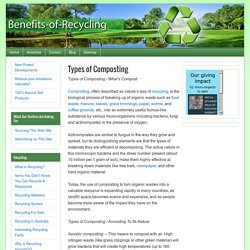
Actinomycetes are similar to fungus in the way they grow and spread, but its distinguishing elements are that the types of materials they are efficient at decomposing. The active nature in this microscopic bacteria and the sheer number present (about 10 million per 1 gram of soil), make them highly effective at breaking down materials like tree bark, newspaper, and other hard organic material. Organic Farming Methods. The methods that make use of the various traditional agricultural practices like minimum tillage, composting, crop rotation, biological pest control, etc., and exclude the application of synthetic fertilizers, insecticides, growth regulators, and genetic modification of crop species, are included in organic farming.

The use of modern technology in combination with organic practices, helps in creating a balanced and sustainable environment for crop growth. Organic farming take a holistic approach in growing crops, rather than exploiting the available natural resources. The International Federation of Organic Agriculture Movements (IFOAM) carries out the worldwide tasks related to setting standards, and regulation of organic farming activities. Components. Standard Process Organic Farming Methods. Organic farming methods. World map of organic agriculture (hectares)[1] Organic agricultural methods are internationally regulated and legally enforced by many nations, based in large part on the standards set by the International Federation of Organic Agriculture Movements (IFOAM), an international umbrella organization for organic farming organizations established in 1972.[7] Organic agriculture can be defined as: an integrated farming system that strives for sustainability, the enhancement of soil fertility and biological diversity whilst, with rare exceptions, prohibiting synthetic pesticides, antibiotics, synthetic fertilizers, genetically modified organisms, and growth hormones.[8][9][10][11] History[edit] Agriculture was practiced for thousands of years without the use of artificial chemicals.
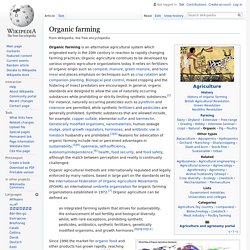
Artificial fertilizers were first created during the mid-19th century. Community Supported Agriculture. Organic Pest Control and Pesticide: Do it yourself pest control and homemade organic pesticide, natural. How do you make homemade Fish/Seaweed Emulsion? - "Do it yourself" pest control / Homemade pesticides, fungicides, and fetilizers for the organic gardener. Tomato leaf spray Add four or five pints of water and 1 tablespoon of cornstarch to tomato leaves crushed in your vegetable juicer.
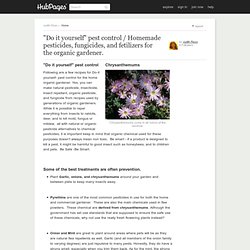
Strain it. Keep the unused spray refrigerated. Good fro all kinds of plants, vegetable and roses. Milk spray - a fungicideSpraying diluted milk on cucumbers and other squash family plants kills powdery mildew. Make Your Own Compost - How To Make Your Own Compost. Any herb gardener will benefit from adding nutrients and organic matter to the soil in order to grow plants well.

One of the most popular and beneficial things to add is compost. Compost can be purchased at any garden supply center, but it is very easy (and less expensive) to make your own. Whether your garden is indoors or out, compost will help all your herbs grow better. How do I start growing organic green beans, tomatoes, or lettuce in my kitchen? Soil-Free Hydroponic Gardening. Soil-Free Hydroponic Gardening Provides Maximum Yields In Minimum Spaces Since plants grown in a soil-free environment are essentially spoon fed and don't have to compete with others for nutrients or water, a significantly larger number of plants can be produced in a given space than if grown by traditional field methods in soil.
Trials conducted by Cornell University's Controlled Environment Agriculture (CEA) Commercial-Scale Lettuce Production Prototype has achieved soil-free lettuce yields equivalent to 470 tons (almost a million pounds) per acre. By comparison, typical production in California using traditional field agriculture is currently about 20 tons per acre.